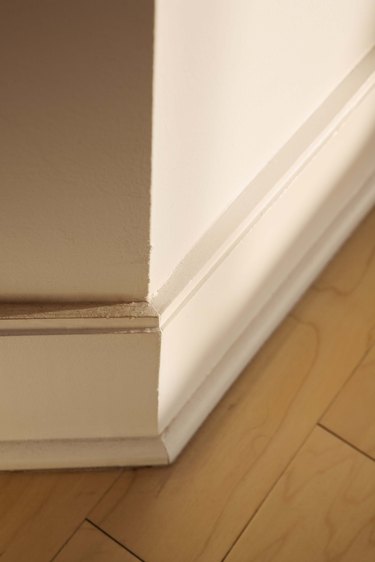
Mildew can be a frustrating problem when it grows on wood. However, mildew growth does not mean the wood is out of commission. With a few basic steps, you can remove mildew from a wooden baseboard and restore it so you can use it once again.
Difference Between Mold and Mildew
Video of the Day
While mold and mildew are both fungi that require damp environments to thrive, they are not the same and require different removal processes. Because mold burrows deep into the surface on which it is growing, it is trickier to remove than mildew, which grows on the surface. A fundamental way to identify mildew from mold is through appearance. Mildew appears flat on a surface, is typically white or gray, and can often appear powdery. On the other hand, mold appears raised and fuzzy on a surface and comes in various colors.
Video of the Day
You can also differentiate mildew from mold through smell. Mildew often has a mild musty smell, while mold's smell is much more intense due to the compounds it creates as it grows. Typically, mildew indicates more minor damage than mold. Because mildew is a surface fungus, it is easy to spot in damp areas, and you can remove it with everyday household cleaners. However, mold burrows deep and can often require professional removal.
How to Prevent Mildew
While you cannot always avoid mildew, there are a few essential preventive measures to take to decrease the likelihood of mildew returning, such as keeping the surrounding area clean, avoiding dampness and keeping the air dry. Mildew requires food to grow, so it is crucial to keep the area clean to prevent mildew. Soil and grease on wooden baseboards or other surrounding items can provide enough nutrients for mildew to thrive, so it is vital to keep the area clean.
Damp conditions can also lead to mildew growth, which is why it is essential to store items you wish to be mildew-free away from damp areas, such as basements. However, dampness can also occur when high humidity is in the air.
Waterproofing steps, such as replacing cracked mortar, improving outside drainage and applying waterproof coatings to walls, can improve damp conditions. Cutting down on the air's overall moisture levels will also help prevent mildew from developing. You can do this with air-conditioning systems or dehumidifiers.
Removing Mildew From a Wooden Baseboard
Unlike mold, mildew is surface level, making it easier to remove from a wooden baseboard. Before beginning the removal process, ensure the workspace is well ventilated and that you have a vacuum with a brush attachment to vacuum loose mildew spores. Then, identify the best cleaning solution for the job. Use a mild cleaner for a painted wooden baseboard, such as a mixture of household detergent and water, or a mild mold removal cleaning product.
However, mildew on unfinished wooden baseboards will have penetrated deeper into the wood and requires a more concentrated solution, such as rubbing alcohol or a more potent mold removal cleaning product. Select a solution, soak a cloth in it and gently scrub the affected area in a circular motion. Allow it to dry thoroughly before moving on. Once dry, disinfect the wooden baseboard with a 10 percent bleach to water solution. If the baseboard is painted or stained, use a mild disinfectant.
Lastly, allow the baseboard to dry completely and then store it in a dry location to prevent further mildew growth.